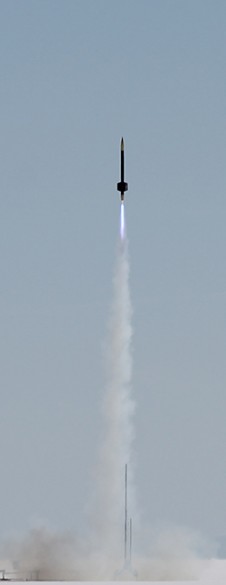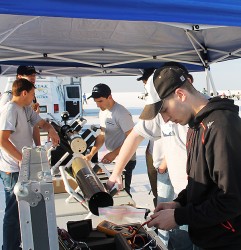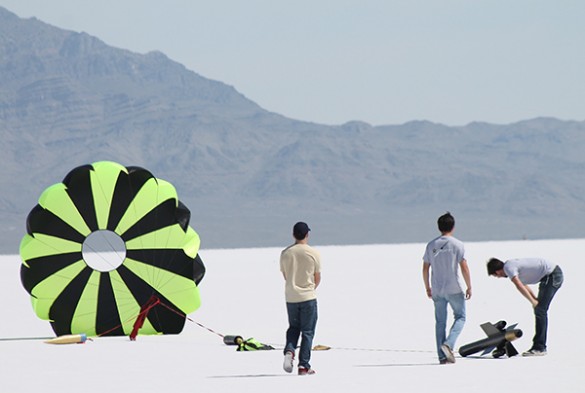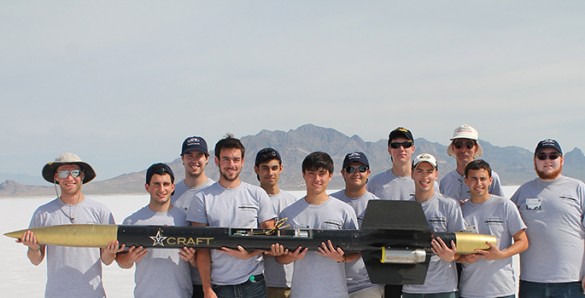On Saturday morning, May 17, on the storied Bonneville Salt Flats in Utah, the 10-foot, black-and-gold StarCRAFT rocket blasted into the still blue sky in a flawless flight that reached an altitude of 4,850 feet before popping its parachute and drifting serenely back down to earth.
The students from Vanderbilt’s Aerospace Club who created and built the rocket were the defending champions in NASA’s national rocket competition, pitting them against teams from 31 other universities, including Cornell, Northwestern, UNC Charlotte, University of Illinois Urbana Champaign, Purdue, University of Florida, Mississippi State, Notre Dame, University of Alabama and Auburn.

For the second year in a row, their rocket’s picture-perfect performance propelled them to a first place finish in the annual competition, which includes much more than simply designing and building a reusable rocket. The contest stretched over nine months and required the design and flight testing of three payloads, preparation of detailed engineering reports, rocket flight tests, creation of a website and community outreach efforts. Each teams’ progress was evaluated throughout the year by NASA engineers, contractors and aerospace industry advisers.
In fact, the contest is so arduous and the competition has become so stiff that several major engineering schools have stopped participating in recent years. Of the 31 teams that began the contest, only 16 made it to the launch-day face off in Utah.
In the seven years it has been competing, Vanderbilt’s Aerospace Club has racked up an impressive record. They have won the award for the best payload design four times and twice each for their educational outreach program, website design and closest-to-altitude performance, meaning that the altitude the rocket reached was closest to the 5,000 foot target altitude. In 2011 and 2012, they came in third overall. Last year they came in first overall and this year they topped their previous performances by winning four of the six major category awards – project review, web site design, educational engagement and closest to altitude – as well as receiving the overall award.
“The Aerospace Club projects defy sorting and are at an advanced level; what distinguishes our program is the novelty of our payloads and the quality of engineering data we are able to generate. We have examined energy regeneration from the exhaust heat of rocket engines and the use of biofuels in hand-fabricated jet engines piggybacking on the rocket flight,” said Professor Amrutur Anilkumar, the faculty adviser and club director.
This year the StarCRAFT rocket carried three separate payloads: a fuel delivery system with a novel method for keeping the fuel from sloshing around in the fuel tank; a biofuel-powered ramjet engine that demonstrated jet engines can be powered by renewable forms of energy; and a camera-based “camjet” for detecting hazards during landings.
The experience had a major impact on the students who participated:

“Launch day started at 4 a.m., leaving the hotel for a two-hour drive to the launch site and the final drive on the salt flats was just surreal; not a tree or an animal or bird in sight, just the mountains and salt on the floor,” said Chris Twedell, who served as the student launch director, graduated in May and will soon begin working as a launch engineer at Lockheed Martin.
“Our rocket took off straight as an arrow, proving that we had balanced the weight and aerodynamic drag on the external ramjet and camjet payloads perfectly,” said Jordan Salik, the computational fluid dynamics expert on the team.
“The ramjet engine ignited four seconds into flight perfectly as planned and sustained combustion for the next eight seconds,” according to club president Brandon Dimmig, who has accepted a job as an instrumentation engineer with the nuclear submarine builder Huntington Ingalls Industries.
“The landing hazard system images captured were not only of high resolution to resolve hazards, but were also processed on board the rocket fast enough and this may set the base for future smarter landing systems,” observed William Emfinger, a third year graduate student in electrical engineering, who led the camjet design efforts.
“[rquote]This has been an extraordinary challenge at a high level engineering integration; perfection at its best.[/rquote] I feel like now, I have the confidence to go and study fundamental problems at graduate school, without worrying about how all these will be integrated,” said Kevin Bush, who is heading to Stanford University to study energy engineering.
“This has been a culmination of an excellent senior year for the six of us mechanical engineering seniors on the design team; we have really enjoyed spending countless hours tackling the most complex problems in vehicle and payload design. I finally feel like I have graduated,” said Patrick Foran, who will join Space-X as a design engineer.
“It is gratifying to note that the students are getting one-of-a-kind jobs after going through this rigorous program,” commented Robin Midgett, electronics technician in the mechanical engineering department who was the safety officer and rocketry mentor for the team.

The excellence of the team’s engineering design efforts has been matched by the effectiveness of their unique outreach program. Several years ago the club teamed up with Heather Johnson, assistant professor of the practice of science education at Vanderbilt’s Peabody College of Education, to produce a framework that uses the design, construction and launch of bottle rockets to introduce basic engineering principles to middle schoolers. In addition to providing these lessons to students in the Nashville area, club members brought the excitement of rocketry and engineering to students in a number of rural Tennessee schools. Altogether their educational efforts have reached nearly 3,000 children. For more information about the outreach program, see: Bottle rockets pique middle schoolers’ interest in engineering.
NASA was equally impressed with the website the team created to document the progress of their project throughout the year and included an aerospace blog maintained by Shiva Bernath, a senior in mechanical engineering and mathematics who served as a design engineer and webmaster.
The Aerospace Club activities are funded by the Tennessee Space Grant Consortium and the Department of Mechanical Engineering.
